Since its Founding, the United States of America has limited the federal government’s purview to a handful of responsibilities. The federal system was designed so that national policymaking would typically be limited and respect plenary governance of the states.REF
These founding principles broke down in the first half of the 20th century, especially under the Administration of President Franklin Delano Roosevelt. The rapid accumulation of power by the federal government and the executive branch has had many deleterious effects, not the least of which is the winner-take-all stakes that arise during presidential elections.REF
These problems have escalated under President Joe Biden. His Administration has used executive orders, regulatory actions, and administrative decisions to steer large volumes of taxpayer-funded resources to promoting radical ideological causes and imposing greater federal control over the nation and economy. Although Congress has enabled some of these actions by broadly delegating authority to the executive branch, the Biden Administration has also circumvented or outright violated federal laws in pursuit of its agenda.
While Congress should assert itself more forcefully against the Biden Administration’s overreach, it is equally important that Congress seek lasting reforms to rein in both the power and discretion of executive agencies. Refocusing the federal government on its core duties would reduce the number of avenues for the Biden Administration or any future Administration to overstep its bounds.
Pursuing Leftist Goals Through “Whole of Government” Actions
It is generally accepted that an executive official will enter office with an agenda based on ideological preferences. For a President, this agenda will be at least partially implemented through executive orders, regulations, and other administrative decisions, and more, pursuant to existing law.
Typically, an Administration will seek to achieve policy goals directly through relevant agencies and programs. Given the incredible scale of the federal government and the steady delegation of power from Congress to the agencies of the executive branch, these direct channels of authority provide an Administration with many opportunities to move its agenda forward while bypassing the legislative process envisioned by the Constitution.
The Biden Administration has doubled down on this trend and taken an aggressive “whole of government” approach, meaning that novel and contentious policy initiatives are undertaken by the entire federal apparatus at once.REF Examples include climate policy, race and identity issues, and labor policy.REF The whole-of-government approach means that the ideological missions are applied to as many agencies and programs as possible simultaneously.
The accumulation of add-on policies causes dysfunction in affected government activities. New York Times columnist Ezra Klein coined the term “everything-bagel liberalism” to describe the increasing tendency of Democrats to set up initiatives that incorporate a multitude of leftist policy goals at once, leading to a dramatic increase in costs for discrete projects that must now account for a myriad of requirements and interest groups (or “stakeholders”).REF This phenomenon has become especially prevalent in major urban areas, and the Biden Administration (heavily staffed by leftists from major urban areas) is spreading this mindset nationwide.
Identity Politics Run Amok. A quintessential example of this mindset is visible in the Administration’s obsession with identity politics. Terms such as “equity” and “justice,” along with references to “disadvantaged” and “underserved” groups, are sprayed in regulations, executive orders, and press releases throughout the entirety of the federal government.
Biden’s Executive Order 13985 dealt with “racial equity.” The Administration officially defines “equity” as “consistent and systematic fair, just, and impartial treatment of all individuals.” These are worthwhile goals. In practice, however, equity means the opposite of “impartial treatment”; it ends up translating into unequal treatment in favor of members of a long list of “underserved” or “marginalized” identity groups that are mostly based on race.REF That is because the practical application of “equity” by the modern Left focuses on equal outcomes, which is inherently socialistic.
This preferential treatment for certain groups is anathema in a pluralistic democracy, where the principle of equal treatment before the law is vital.REF One example is the unconstitutional racial quotas for government contracts, particularly in the context of infrastructure projects. The Administration boasts that this will create “generational wealth” for chosen minorities who receive preferential treatment, which is an obviously unhealthy way to approach the subject.REF
Executive Order 13985 led to the production of Equity Action Plans across the federal government, changing hundreds of policies and programs. The production and implementation of the plans required an untold number of work hours that federal employees would have otherwise devoted towards their core duties. Similarly, agencies will devote an untold amount of effort to carrying out the plans moving forward.REF
These burdens extend beyond the federal government. For example, in 2022, the Department of Energy implemented a requirement that applicants for research grants include a “Promoting Inclusive and Equitable Research Plan” describing how their project would “promote diversity, equity, inclusion, and accessibility.”REF This requirement will not only impose bureaucratic costs during the application phase but will also mean devoting a portion of the grant funding to meeting the federal social agenda mandates.
Environmental Radicalism. In a similar vein, Executive Order 14008 claims that America must achieve “significant short-term global reductions in greenhouse gas emissions and net-zero global emissions by mid-century or before.”REF This approach to “climate change” and “environmental justice” will impose tens of trillions of dollars in costs on the economy, with much of the burden falling on the poor, farmers, and small businesses, lowering the standard of living for all Americans, with negligible environmental benefits.REF
This order was then used as the basis for the government-wide Justice40 initiative, which has the stated intention of having “40 percent of the overall benefits of certain Federal investments flow to disadvantaged communities” from all Cabinet agencies. The stated goal of Justice40 is to improve environmental conditions in high-poverty areas.REF However, rather than enhancing the quality of life for genuinely poor neighborhoods, these practices will simply cause tremendous amounts of waste and inefficiency.
For example, the Administration is devoting a portion of subsidies for electric vehicle charging stations to “disadvantaged” areas based on Justice40, even though the ownership and usage of such vehicles is clustered in high-wealth areas.REF In turn, these effects have been coupled with the Administration’s practice of designating portions of posh jurisdictions, such as Martha’s Vineyard and New York’s Montauk, as “low-income.”REF The designation is based on certain neighborhoods having lower average income than other parts of the area, rather than being low income in absolute terms. Thus, the Administration attempts to present itself as serving the needy while subsidizing the lifestyle habits of the coastal elite.
Debasing Science. Not every government-spanning initiative by the Biden Administration has required an executive order. A memorandum from the Office of Science and Technology Policy and the White House Council on Environmental Quality in November 2022 called on the federal government to use Indigenous Knowledge (IK), which is associated with tribal communities and cultures.REF
While it is reasonable for federal agencies and scientists funded by federal grants to collaborate with tribal communities and individuals as part of information-gathering activity, the promotion of IK is problematic. This is because IK is often rooted in cultural practices and folklore, which means that IK generally lacks scientific rigor. Elevating IK in core federal science documents risks weakening—rather than strengthening—the scientific quality of federally financed research.REF It is also important to recognize that trends such as the promotion of IK are in line with assaults on fundamental concepts of facts, reason, and objectivity, all of which seek to empower radical identarian philosophy and activists.REF
Since federal research grants inform policy at all levels of government and are a significant funding source for academic departments, flawed guidance can have severe consequences. This has led to several policy and funding shifts:
- The Department of the Interior cancelled seven oil and gas development leases in Alaska in September 2023 and cited IK as a factor in the decision. Accordingly, IK provides an Administration that is inherently skeptical about authorizing energy development with a new tool to block permits.REF
- The National Science Foundation created a Center for Braiding Indigenous Knowledges and Science in September 2023 with a purported $120 million in funding over five years.REF This shows that the Administration’s use of IK is not merely window dressing but a concerted promotional effort to intertwine IK with science and research.
- In July 2023, the National Oceanic and Atmospheric Administration released guidance to promote IK throughout its decision-making process.REF
- The Administration’s proposed policy governing scientific integrity at agencies such as the Department of Health and Human Services and the Environmental Protection Agency would enshrine IK as part of federal science policy in sensitive areas such as medicine and the environment.REF
Accordingly, the Administration has integrated a former niche concept (IK) into several agencies and multiple policy areas within a relatively brief period.
Although federal courts have often allowed Presidents significant administrative leeway, dramatic federal policy shifts are supposed to originate from Congress under the American system of divided powers.REF This separation of powers is designed to ensure that policies substantially affecting the entire country are born out of a broad consensus. But the people’s representatives in Congress did not pass legislation to establish wide-ranging initiatives on topics such as “equity,” “environmental justice,” or “Indigenous Knowledge.” The Biden Administration’s repeated use of “whole of government” actions to impose such policies fails to respect the American people’s right to govern themselves.
Funding Opportunities and Ideological Capture
A largely overlooked example of the Biden Administration’s whole-of-government application of leftist ideology is the insertion of non-statutory preferences and requirements into federal grantmaking and procurement activity.
This often takes place in Notice of Funding Opportunity (NOFO) documents published in the Federal Register. A NOFO is a formal invitation for applicants to seek funds from a program. In theory, the terms of each NOFO are based on a combination of the specific statute that funded the program along with other statutes governing the policy area. However, the Biden Administration leans on its own wide-ranging and often unconstitutional executive orders to justify ideologically motivated criteria that are divorced from legislative text and intent.
Another method the Administration uses to apply ideological preferences not enacted by Congress is through “guidance” documents, wherein an agency will attempt to issue de facto mandates on the use of federal funds without proper notice-and-comment rulemaking.
The Biden Administration notably sought to use a guidance document to shift the federal highway program in the direction of funding maintenance activity rather than capacity expansion projects. The document used language from highway legislation introduced by former Representative Peter DeFazio (D–OR). DeFazio’s bill did not pass, and the language was not contained in the 2021 Infrastructure Investment and Jobs Act (IIJA), but President Biden’s Department of Transportation tried to enact it through backdoor guidance. Senate Republicans took Transportation Secretary Pete Buttigieg to task for this, and the Administration subsequently backed down.REF
To the detriment of the nation, the bulk of the Biden Administration’s whole-of-government scheme is moving forward. A noteworthy aspect is the number of infrastructure programs affected by the insertion of terminology and dictates, which increase the cost and completion time of projects. Even when a concept is only “encouraged” in NOFOs, applicants will have a strong incentive to adjust their proposals to curry favor with the Administration and left-leaning agency bureaucrats.REF
Since state and local governments are the largest recipient of competitive grants, the Administration’s moves have the added effect of coercing these governments into adopting the same ideological bend if they want a full share of the funding streams paid for by taxpayers from their states. This is part of a long-term trend of the federal government steadily encroaching on state and local sovereignty, which has worsened the nation’s governance and undermined aspects of the nation’s founding principles.REF
Ideological terms and conditions bundled into NOFOs by the Biden Administration include:
- “Racial Equity.”
- “Climate Change.”
- “Environmental Justice.”
- Diversity, equity, and inclusion (DEI). One of the centerpiece concepts of the activist Left, DEI entails massive bureaucracies micromanaging government, society, and the economy based largely on immutable characteristics.REF
- Project Labor Agreements (PLAs) and “Prevailing Wage.” These are labor mandates that impose union-style work rules and artificially inflate compensation, driving up costs and largely freezing out non-unionized contractors. PLAs sometimes contain preferences for hiring local workers, which further demonstrates that the Administration views infrastructure primarily as an expansive jobs program—draining resources from productive industries.REF President Biden’s Executive Order 14063 expanded the use of PLAs, and the Administration is adjusting wage requirements under the Davis–Bacon Act to further increase mandated compensation. According to the Department of Transportation, roughly $10 billion in highway projects alone are already subject to PLAs.REF
Table 1 lists infrastructure NOFOs issued by the Biden Administration, along with which ideological terms were applied to each.
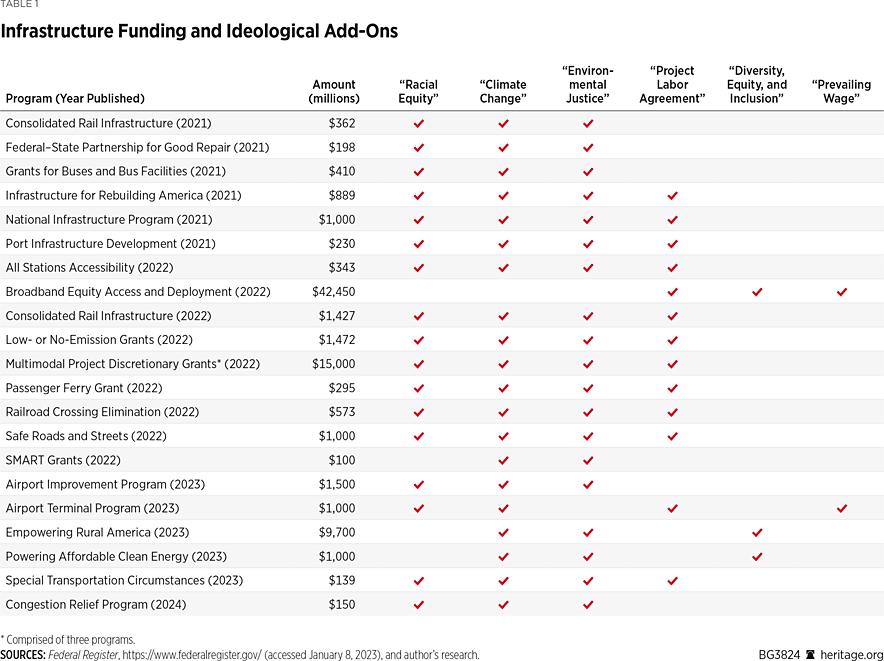
In a positive example of congressional oversight, the House Transportation and Infrastructure Committee held a hearing on March 7, 2024, to highlight the Administration’s implementation of infrastructure programs. The hearing included discussion of how the Administration’s bureaucratic and ideological NOFOs increased the amount of time and effort required by state and local governments to apply for grants.REF
Alan Winders, Presiding Commissioner of Audrain County, Missouri, stated in written testimony that “non-statutory NOFO criteria has proved difficult for some counties, especially small, rural and first-time applicants.” He added: “To competitively respond to NOFOs, counties across the country are investing tens of thousands of dollars in consultant services to produce applications that have no guarantee of success.”REF
Winders’s statement makes it clear that the Biden Administration’s regulatory baggage increases the cost of both administering and complying with the programs, resulting in fewer projects being completed for the given amount of funding. In addition, many lower-value projects will be selected for competitive grants based on closer adherence to leftist ideology, and smaller jurisdictions are placed at a disadvantage. The Biden Administration’s approach worsens inflation for the government sector and increases costs to taxpayers for the sake of nebulous and often counterproductive social goals.
The most striking example of the Biden Administration’s abuse of NOFOs relates to the Creating Helpful Incentives to Produce Semiconductors (CHIPS) and Science Act, which included $79 billion in subsidies and loans to the semiconductor industry. While the act was already flawed when passed in 2022, the Administration has gone to great lengths to make the initiative a monumental exercise in economic and ideological micromanagement.REF
In addition to “environmental justice,” PLAs, and DEI provisions like those outlined above, the CHIPS NOFOs require:REF
- Childcare benefits for employees of grant recipients,
- A “climate and environmental responsibility plan,” and
- Returning “excess profits” of up to 75 percent of awarded funds to the government.
Congress did not include any of those burdens in the CHIPS Act. However, each of those conditions aligns with the agenda of the activist Left.
The childcare provision is especially telling since the Administration proposed a federal childcare program in 2021 but failed to secure sufficient congressional support. Although providing benefits, such as childcare, makes sense for some businesses, mandating fringe benefits artificially inflates the cost of labor and can cause workers to lose out on cash wages over time.REF
The combination of existing federal regulation and taxation of businesses, mandates imposed through laws such as the CHIPS Act, and further mandates added through NOFOs create an astonishing degree of bureaucratic control over corporations that receive funding. This is a recipe for European-style corporatism, which breeds economic stagnation.
However, the Biden Administration’s machinations are not as productive as they had expected. Despite the tremendous amount of spending authorized for the programs subject to the NOFOs above, both the IIJA and the CHIPS Act have struggled to produce noteworthy projects, causing consternation within the Administration. Ironically, the Administration’s habit of adding to already cumbersome federal red tape is partially responsible for the slow uptake.REF
Radical Grants Waste Taxpayer Resources
While much of the activity cited above involves instances of exceeding statutory authority, the Biden Administration has more plausible deniability when it comes to its management of federal grant programs. Congress has created billion-dollar slush funds for many policy areas, and there is rarely oversight or accountability when agencies sign off on wasteful and inappropriate grants. However, this does not excuse instances of agencies rubber-stamping ideological projects with the blessing of the Administration, especially when doing so means further coercing state and local governments to follow the same ideological path.
Education. In recent years, ideological concepts, such as DEI, critical race theory, intersectionality, “social and emotional learning,” and more, have gained an increasing foothold in educational institutions and fields of study. Schools at all levels are hiring bureaucrats whose sole focus is creating and enforcing rules based on these concepts.REF The trend is even consuming non-humanities areas, such as science, technology, engineering, and math (STEM).
The Biden Administration is using federal funds to promote the further ideological capture of education’s commanding heights. While many of these grants come from the Department of Education, agencies, such as the National Science Foundation (NSF), are also complicit,REF as Table 2 shows.
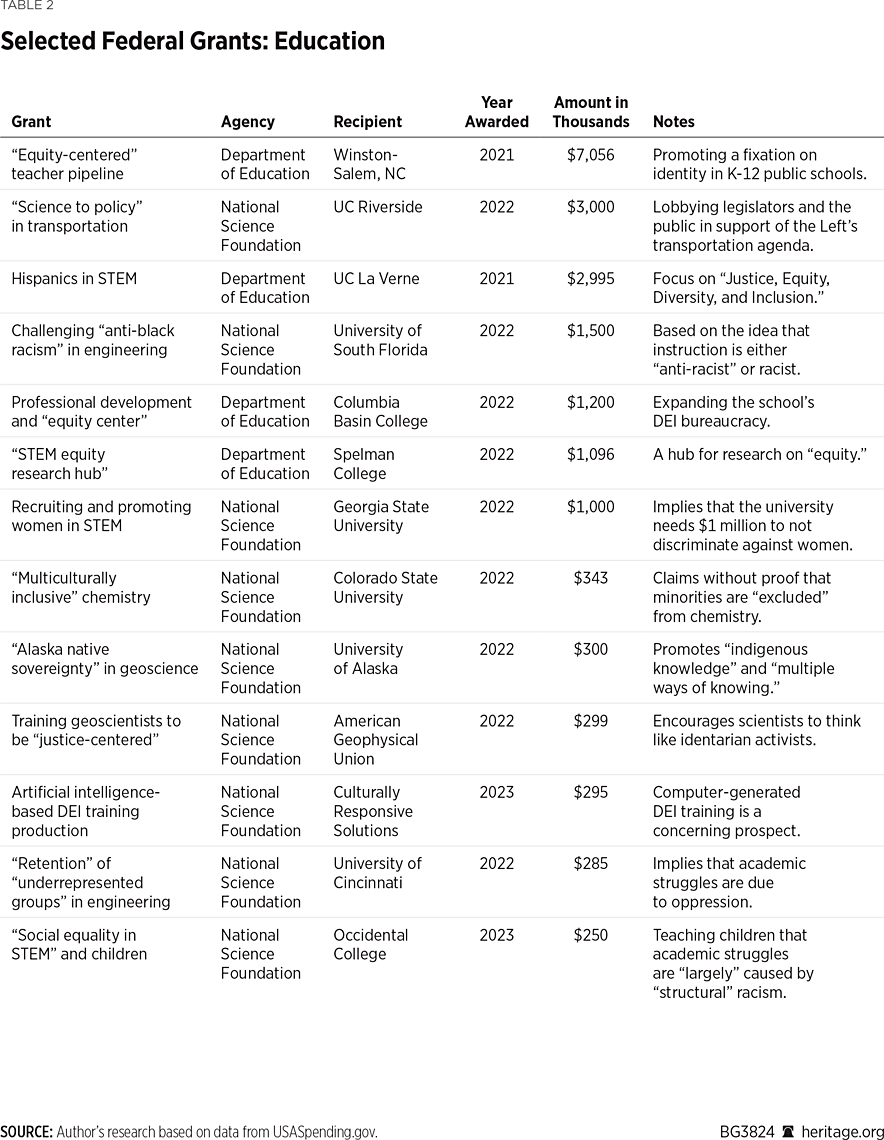
A 2022 NSF grant to the American Geophysical Union for “justice-centered” training is a telling example.REF It calls for scientists to “collaborate with community leaders” of “historically marginalized” groups and “incorporate guidance” from “minority-serving institutions.” In turn, the work will “enlarge the concept of what counts as science” and “build bridges between science and other ways of knowing,” which would degrade scientific integrity.
The NSF also provided a grant to University of California Riverside in 2022 for a “science to policy” program. As described in the proposal, this inherently involves lobbying legislators in support of environmentalist transportation preferences, a highly inappropriate use of tax dollars.REF Other grants are awarded based on the notion that unequal outcomes in STEM fields are primarily or solely caused by “systemic racism” and that grant recipients must become “anti-racist,” a misnamed ideology that is itself steeped in race essentialism.REF
Subsidies for this type of training are designed to mold institutional and professional cultures—enforcing the sense that having an academic job today means being an activist when it comes to socially fashionable causes. This goes beyond merely wasting tax dollars; the Biden Administration is undermining intellectual life and causing long-term damage to higher learning in America.
Foreign Policy. The federal government spends tens of billions of dollars per year on foreign aid through the State Department, the U.S. Agency for International Development, and other federal agencies. While some foreign aid efforts are judicious, there are also problems with the status quo and a need for significant reforms.REF
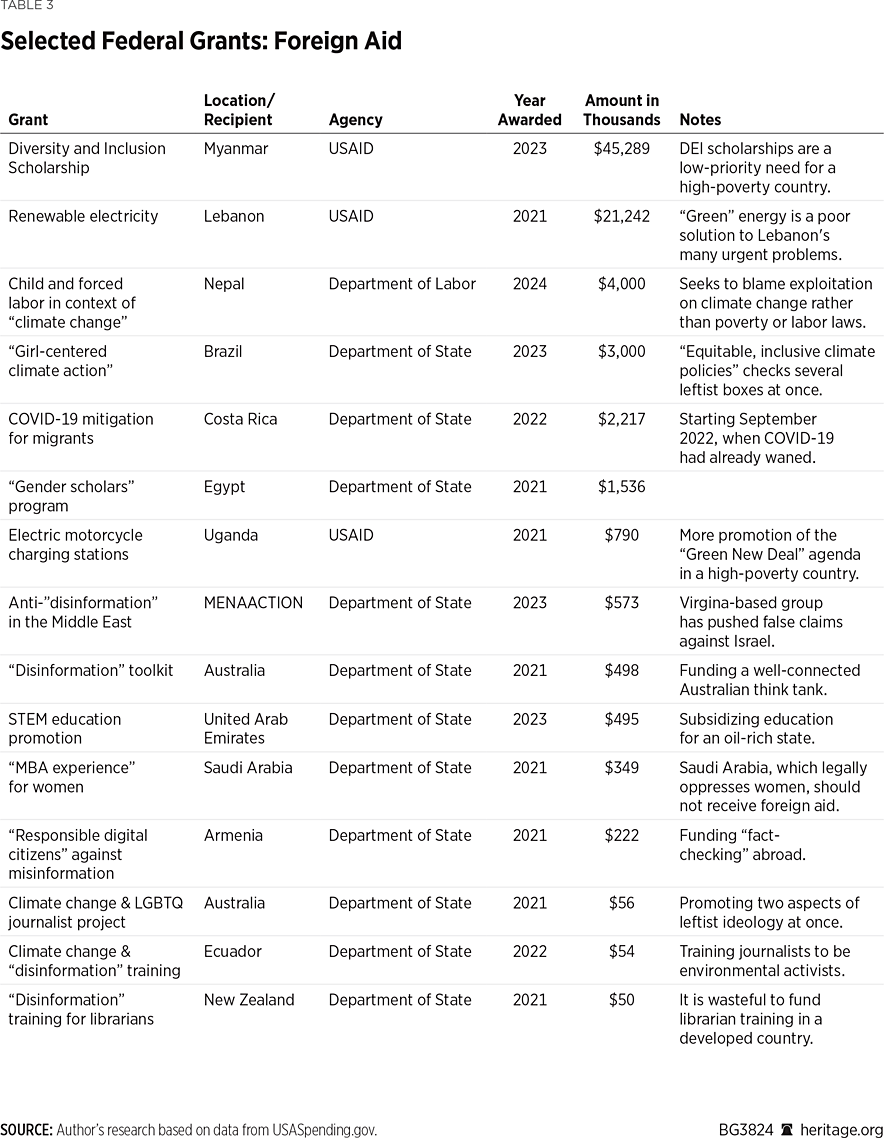
As Table 3 shows, the Biden Administration—in conjunction with a global alliance of leftist nongovernmental organizations—is using foreign policy as a sandbox for promoting divisive ideological goals abroad.REF This includes approving grants promoting the “LGBTQIA+” movement, addressing “disinformation,”REF DEI-style identity politics, and “green” projects. These grants fail to promote values broadly shared by Americans and damage the nation’s global standing in countries that resent violations of their religious values and cultural norms.
Grants for discretionary domestic activities in developed nations, such as Australia and New Zealand, or oil-rich states, such as Saudi Arabia and the United Arab Emirates, are not an appropriate use of tax dollars under normal conditions, and especially not at a time of fiscal strain. Conversely, development grants that spend millions of dollars on second-order concerns, such as “diversity” and “renewable” energy, amid a backdrop of severe poverty in Myanmar or Uganda show a lack of perspective.
In the case of $573,046 in grants to Virginia-based group MENAACTION (Middle East/North Africa ACTION)REF to address “disinformation” in the Middle East, the spending is likely to be actively harmful. MENAACTION and its leaders have promoted a warped perspective on the war between Israel and Hamas, including thoroughly debunked claims about Israel having bombed a hospital when the cause was a terrorist-fired rocket.REF Such an organization is unlikely to have good discernment about what is and is not disinformation.
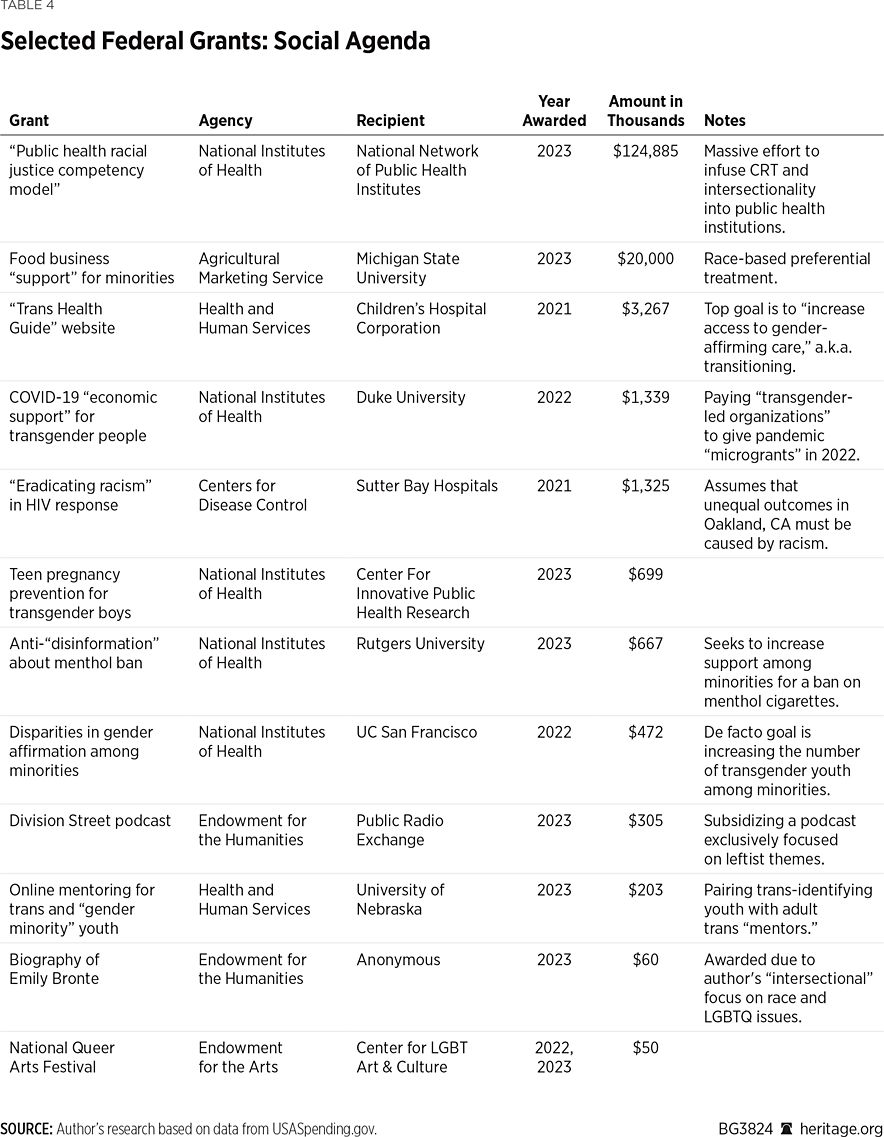
Social Policy. The Administration is also using grants to promote leftism on issues such as race and sexuality. Grants for “gender-affirming care,” providing children with adult trans “mentors,” and other promotion of transgenderism are especially concerning. Emotionally troubled children are besieged by misleading messages that the solution to mental health challenges or discomfort with puberty is invasive surgical procedures, and parents struggle to protect their children from destructive life choices. The Biden Administration is taking the side of a radical movement that seeks to warp core facets of human existence.REF
The Centers for Disease Control gave an astonishing $125 million grant to the National Network of Public Health Institutes (NNPHI) in 2023 for a multi-year project to change public health institutions.REF The language of the grant is unmistakably ideological, focusing on outcome disparities between identity groups and claiming that this is evidence of “racism in public health practice.” The grant references NNPHI’s “racial justice competency model,” which is designed to infuse CRT-inspired dogma into medical practices.REF
Boondoggles. There is a storied history of wasteful federal grants. Subsidizing a video game initiative in the United Arab Emirates or spending $43 million to replace a dock in a remote Alaskan village of 50 people are examples of waste that could occur under any Administration due to the unmanageably large nature of the federal government. However, most items in Table 5 are in line with the Administration’s ideological priorities.
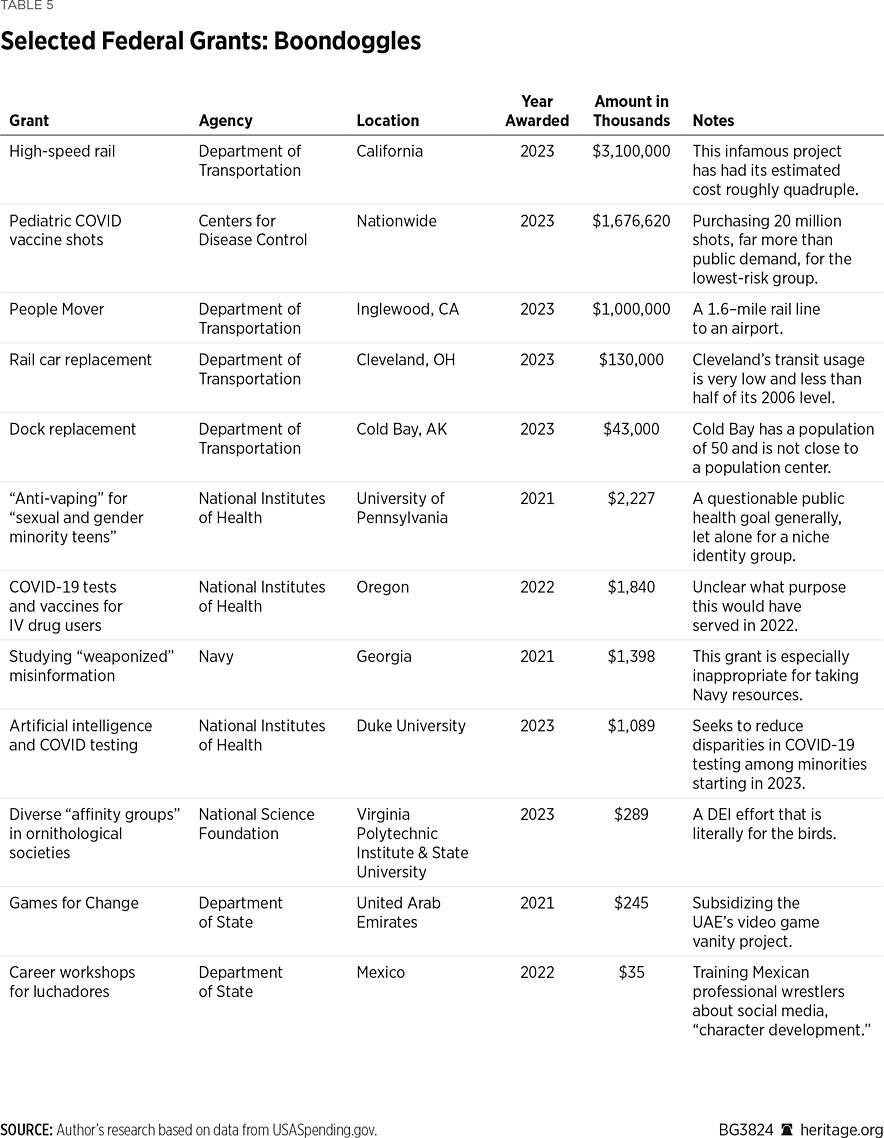
Choosing to devote billions of dollars to California’s dysfunctional high-speed rail project—in addition to previous rounds of federal handouts—only makes sense in the context of the activist left’s infatuation with rail.REF The purchase of 20 million doses of COVID-19 pediatric vaccines in 2023 involved layers of policy failure, since children are at low risk of severe infection and there is insufficient demand to justify such a large purchase.REF Funding a DEI initiative for ornithological (bird-studying) groups shows that there is no niche too small for taxpayer subsidies. Finally, devoting any portion of the Navy’s budget to the Left’s campaign against “misinformation” pulls resources from genuine national security needs.
Wasteful spending is endemic to the federal behemoth. What makes these wasteful grants (especially those worth billions of dollars apiece) particularly concerning is that they take place amid a backdrop of high deficits, elevated inflation, and a dire long-term fiscal outlook.REF This shows that the Biden Administration is not being prudent with the bountiful resources entrusted to it by taxpayers.
Recommendations for Congress
The overbearing nature of a federal government that spends too much, regulates too much, and allows leftist special interests to play by their own set of rules serves to sharpen political disagreements and poison discourse. The Biden Administration’s choices outlined above make these problems even worse, imposing radical ideological mandates in a one-size-fits-all manner while running roughshod over Congress and state and local governments.
Although subsequent Administrations can overturn the Biden Administration’s initiatives and diktats, especially by revoking harmful executive orders, much waste and damage will have already been done. The only long-term solutions can and must come from Congress. Congress should:
- Pass the Regulations from the Executive in Need of Scrutiny (REINS) Act, which requires congressional approval for new major regulations to take effect.REF
- Pass Congressional Review Act (CRA) resolutions to strike down regulations that exceed or ignore relevant statutes or are wasteful and unduly burdensome.REF
- Use the appropriations process to defund abusive executive orders and inappropriately selected projects.REF
- End the long-standing practice of providing broad authorizations and de facto slush funds to executive agencies. The current tendency allows legislators to claim to have “done something” about a perceived issue while delegating the work of determining key details to unelected (and often strongly ideological) bureaucrats.
- Streamline the federal government to allow better oversight and provide fewer opportunities for executive branch mischief, especially in policy areas outside the federal government’s core priorities.REF
- Reduce the increasing degree of direct and indirect federal control over state and local governments. In some cases, this would involve legislative prohibitions against executive branch agencies attaching conditions to aid-to-state programs that were not contained in the authorizing law. In other cases, the ideal solution would be the elimination or downsizing of such programs, which would improve federal finances while enhancing state and local autonomy.
- Improve federal science policy by reforming the Information Quality Act. This would include strengthening enforcement mechanisms, judicial review, transparency, and public participation.REF
- Pass a prohibition on the use of DEI and similarly radical, identarian theories from being used as criteria for awarding federal grants and contracts.
- Require agencies to re-justify old regulations through notice and comment rulemakings, or else the rules will automatically sunset.REF This can allow the removal of harmful regulations that survive the CRA’s 60-day window.
Conclusion
The federal government is on an increasingly unsustainable path, both in terms of budgeting and public confidence in the country’s democratic institutions, including Congress and the presidency. Removing excessive funding and authority from federal agencies would improve the fiscal and democratic health of the republic. Congress must act now.
David Ditch is Senior Policy Analyst for Budget Policy in the Grover M. Hermann Center for the Federal Budget at The Heritage Foundation.

